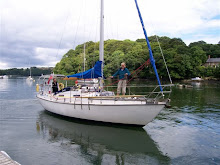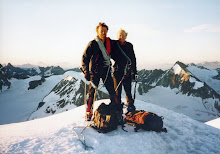Sula sailed from Santa Cruz de la Palma on the morning of 2nd December.
Even then we were delayed. Having gotten everything ready and dragged ourselves out of bed at 6a.m. in order to be able to arrive at Gomera before dark. The harbour master required us to remain in the marina until a cargo ship had berthed. Once we were allowed to leave, a tall ship was entering the harbour and we had to keep well clear. We finally left at 8am and had a pleasant and fast sail to the anchorage at Puerto Vueltas arriving well before dark.
Leaving Santa Cruz
Well, we were leaving.
We met this tall ship as she was arriving.
Well, we were leaving.
We met this tall ship as she was arriving.
On the 3rd of December, after a short lie-in and a leisurely breakfast, we hoisted and stowed the anchor. There was little or no wind so we motored off, but before long were sailing nicely. It wasn’t long after that before we decided to reef in the increasing wind. While I was on deck Pippa called out “You had better put two reefs in, look at those white horses”. I concurred.
Our course followed that of Christopher Columbus all those years ago. It’s amazing and a tribute to his navigational skills that a better route has not been discovered. A slight detour was, however, made in order to avoid the south coast of Hierro island. A new underwater volcano is erupting and sending magma, gas and ash high into the air. Best avoided in a small boat we thought .
We sailed all day and overnight at a cracking pace, but it was very tiring, with spray being thrown about and the crashing and banging as we hit the waves was most uncomfortable.
We couldn’t go on like this! However the main was fully reefed and the genoa was more than half rolled away. If we were to take the main down completely, we knew by experience, that without its stabilizing effect we would roll heavily. What to do? Then it dawned on me.
Our Trysail
I had been preparing the heavy weather trysail and storm jib just in case we hit a gale at some point during our passage. The simple idea was to take down the main and hoist the trysail in its place. It has its own dedicated track on the mast, so this was easy to do. The result was most satisfactory. Our speed was not unduly reduced, we had a much easier ride, and though the rolling did increase, it was quite acceptable.
Our daily runs for the next two days were between 120 & 112 miles. That will do nicely thank you, we are in a small boat and aren’t racing. “It is better to travel peacefully than to overdrive”.
LOG: Wed 7th December.
Quiet passage making thus far. The trysail seems to be working ok, though that is in relative terms. We still roll and occasionally surf down waves. Then, just as one has been lulled into a false sense of security and is stepping up through the companionway hatch with a cup of tea, Sula lurches to one side and rolls heavily for a few moments. Usually some of the tea remains in the cup, but not much!
We had lots of quite big waves
Trade wind sailing
To be honest the 2,800 mile and 23 day passage was quite straight forward. The winds were never too strong nor did they fail. Sometimes the sea was a bit lumpy, often, especially at first, we were very tired. However once settled into the routine, it became a rather tedious means to our Caribbean end.
We kept four hour watches. That is to say we divided the day using the classic navy tradition of watch keeping. So, for example, Pippa would keep the First watch (eight to midnight). I would have the Middle (midnight to 0400). Then Pippa stood the Morning watch (0400 to 0800). And so on at four hour intervals through the Forenoon, Afternoon and Dog watches. The Dogwatches are the exception being two hour watches (First & Last Dogs) so that the watches one kept would rotate.
Calm weather cooking.
In rough seas we need the seat belt.
It worked well and had the merit of each of us getting 4 hour intervals of good quality uninterrupted sleep, and at least 8 hours of sleep each day. Once in the rhythm one was fast asleep within minutes of being relieved at the end of a watch. We were thus able to keep a good lookout for passing ships or other yachts. (We saw two ships and one yacht, all at a safe distance, during the whole passage).
The only other task was to keep Sula sailing well, by reefing or increasing sail as required. Our Hydrovane steering system coped well with all the helming needs. It equated in our estimation to at least two extra members of crew.
Our Hydrovane hard at work
We saw lots of sea. Some of it was bigger than other bits. But mostly it was quite benign. Occasionally it became irksome, and on one occasion sent a solid jet of water straight through the main companion way hatch. It bounced round the cabin, drenching our bed and played hell with our navigational computer.
I did try to get our latitude using the more traditional celestial observation, and shooting the sun with my sextant. However I have to admit that the spare laptop coupled to the GPS made a much better job with far less fuss. However I will persevere. The whole idea of sailing over an ocean, (when nothing goes to windward quite like a 747), is patently ridiculous. Therefore why not go the whole hog and do it in the traditional manner?
Can you please stop the boat rocking for a moment please?
Our wildlife sightings were disappointing. For days on end we would see nothing but the kamikaze flying fish, many of whom ended their days stranded on our deck, their corpses only being discovered the following morning.
The Storm Petrels as already mentioned were regularly seen, fascinating birds.
We also saw a few Boobies. I don’t know their proper name (Though I’m sure some one will tell me. Steve perhaps?). Great brutes of a bird, with a vicious bill, akin to a Gannet, but without any if the latter’s redeeming features.
I caught two fish during the whole voyage. One a Dorade the other I think a Wahoo. My desire for fresh fish however was tainted by the cruelty of dragging them out of the water with a vicious hook. Then bludgeoning them to death, before butchering them for the frying pan. And such beautiful creatures!
Both spectacular, but the Dorade especially so. Bright yellow with hews of blue, such a noble fish! The colour drained out of them almost as one watched.
I have to admit though, that my qualms didn’t stop me enjoying their flesh and albeit unsuccessfully trying to catch more. As my friends in Yorkshire would say. “There’s none so queer as folk”.
Our first sight of land was of Barbados, 50 odd miles to the north. Then next day, dead on course, Grenada. As sods law would have it, it transpired that we would arrive just an hour after dark. And then the wind lulled! Bugger! Our solution was to ditch the main and hoist the spinnaker. This tactic helped no end but still didn’t get us to our harbour of choice (Egmont Harbour) before sunset. First the sun, then a thin waif of a moon set and it was inky black!
The home strait
Egmont was now out of the question, much too difficult and positively dangerous in the dark. However, with the help of our trusty GPS, and detailed reading of the chart, combined with careful monitoring of the echo sounder, we could cautiously enter the unlit Prickly Bay. The alternative was to heave to all night at a safe distance off to await the dawn.
We crept into harbor, all senses alert, cursing other yachts with anchor lights at the top of their masts, which, from our perspective, were higher in the sky than some bright stars. Eventually we quietly anchored, well clear of all other vessels in ten metres. As we sat in the cockpit toasting our arrival in the Caribbean with a glass of something resembling cold tea, we mused on whose watch it was! Not mine was the universal answer. And so we retired to bed.










